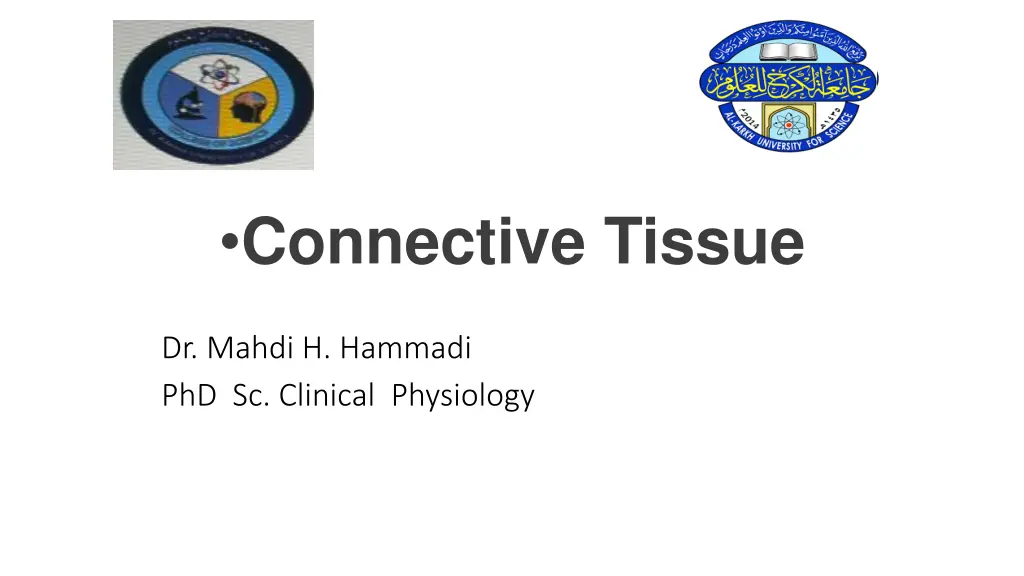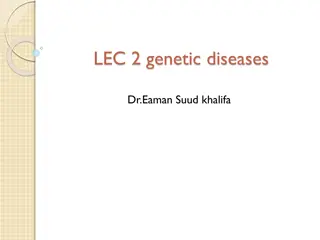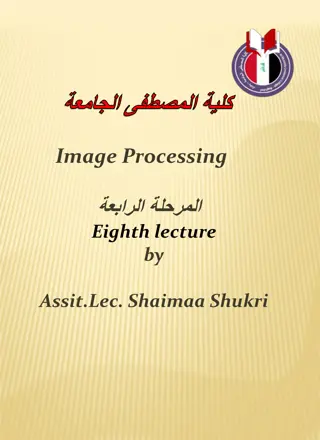
Understanding Connective Tissue and Its Functions
Connective tissue, with its extracellular matrix, provides vital support and connectivity between cells and organs in the body. Dr. Mahdi H. Hammadi explains its functions, such as holding structures together, supporting organ frameworks, enabling movement, and aiding in immunity and tissue regeneration. Learn about the types of connective tissues and their constituents in this informative guide.
Download Presentation

Please find below an Image/Link to download the presentation.
The content on the website is provided AS IS for your information and personal use only. It may not be sold, licensed, or shared on other websites without obtaining consent from the author. If you encounter any issues during the download, it is possible that the publisher has removed the file from their server.
You are allowed to download the files provided on this website for personal or commercial use, subject to the condition that they are used lawfully. All files are the property of their respective owners.
The content on the website is provided AS IS for your information and personal use only. It may not be sold, licensed, or shared on other websites without obtaining consent from the author.
E N D
Presentation Transcript
Connective Tissue Dr. Mahdi H. Hammadi PhD Sc. Clinical Physiology
Connective Tissue Connective tissue provides a matrix that connects and binds the cells and organs and ultimately gives support to the body The main constituent of connective tissue is the extracellular matrix. Due to this abundance of extracellular matrix, the cells in connective tissues are widely placed. Other tissues (like epithelium, muscular and nervous) are formed mainly by cells.
The function of connective tissues: 1. The Loose areolar tissue holds together structures like skin, muscles, blood vessels etc. and binds together the various layers of hollow viscera (stomach, intestine, urinary bladder, uterus). 2. Reticular tissue forms a framework that supports the cellular elements of various organs like spleen, lymph nodes and glands. 3. Enables the movement of skin over underlying structure. 4. Allows mobility and stretching in hollow organs. 5. Hold the bone at joints (in the form of ligament). 6. Provide attachment for origin and insertions of many muscles 7. Hold the tendons of muscles at wrist and ankle Provides support and protection to the brain and spinal cord
Other functions: The matrix serves as medium through which nutrients and metabolic wastes are exchanged between cells and their blood supply. .1 Provides immunity: due to presence of cells of immune system - macrophages and plasma cells. .2 Wound repair: Fibroblast produces the collagen fibres necessary for wound repair. .3 Adipose tissue stores nutrition .4
Regeneration of tissues (like cartilage and bone) due to the presence of undifferentiated mesenchymal cells.
Connective Tissues are broadly classified into: General Connective tissue Specialized connective tissue (Bone, Blood, cartilage)
General Connective Tissue The constituents for general connective tissues are as follow: Cells Fibres Ground substance
Cells Mesenchymal cell Pigment cells Macrophages Lymphocytes Plasma cells
Various other types are also recognized Collagen Fibers: Elastic Fibers Ground substance
Types of Connective tissue Loose areolar- e.g. superficial fascia Dense irregular e.g. dermis of the skin Dense regular- e.g. tendon Elastic Tissue- e.g. ligamentum flava Adipose Tissue Connective tissue is divided into four main categories: Connective proper .1 Cartilage .2 Bone .3 Blood .4
Connective tissue proper has two subclasses: loose and dense. Loose connective tissue is divided into 1) areolar, 2) adipose, 3) reticular. Dense connective tissue is divided into 1) dense regular, 2) dense irregular, 3) elastic
1- Loose Connective tissue: Areolar Connective Tissue Image result for areolar connective tissue
Elastic Connective Tissue The main fibers that form this tissue are elastic in nature. These fibers allow the tissues to recoil after stretching. This is especially seen in the arterial blood vessels and walls of the bronchial tubes.



![Lec [2] Health promotion](/thumb/274962/lec-2-health-promotion-powerpoint-ppt-presentation.jpg)
